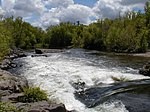Windsor Farms Historic District
Colonial Revival architecture in ConnecticutGreek Revival architecture in ConnecticutHistoric districts on the National Register of Historic Places in ConnecticutNational Register of Historic Places in Hartford County, ConnecticutSouth Windsor, Connecticut ... and 2 more
Use mdy dates from August 2023Victorian architecture in Connecticut

The Windsor Farms Historic District encompasses a large historically agricultural area and the historic town center of South Windsor, Connecticut. Its built environment extends mainly along Main Street, between Interstate 291 in the south and Strong Road in the north, with a diversity of architecture spanning three centuries. The district includes agricultural fields on both sides, many of which remain in tobacco cultivation. The district was listed on the National Register of Historic Places in 1986.
Excerpt from the Wikipedia article Windsor Farms Historic District (License: CC BY-SA 3.0, Authors, Images).Windsor Farms Historic District
Vibert Road,
Geographical coordinates (GPS) Address External links Nearby Places Show on map
Geographical coordinates (GPS)
| Latitude | Longitude |
|---|---|
| N 41.822777777778 ° | E -72.626388888889 ° |
Address
Windsor Farms Historic District
Vibert Road
06028
United States
Open on Google Maps











